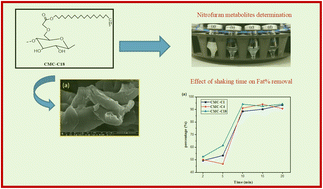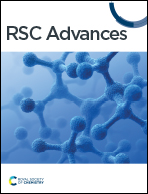Hydrophobic carboxymethyl cellulose as a clean-up sorbent in the determination of nitrofuran metabolites in animal-fat samples
Abstract
Hydrophobic carboxymethyl cellulose (CMC) biopolymers were fabricated for the removal of fat from food sample matrices. The hydrophobic CMCs were synthesised via the esterification of CMC with three alcohols with carbon chains of different lengths, methanol, butanol, and octadecanol, in the presence of sulfuric acid. The structure of the three synthesised hydrophobic CMCs was verified using FT-IR, and the physicochemical properties were investigated by TGA, SEM, and X-ray. Characterization confirmed the successful synthesis of the hydrophobic CMCs and that the hydrophobic groups are embedded in the sorbent biopolymer to interact with fat and reduce the fat content of the sample extract. Moreover, the performance of the fabricated hydrophobic CMCs was studied in two applications: fat removal and the determination of nitrofuran (NF) metabolites in fat samples. In the first application, excellent results were observed for fat removal; the highest percentage of fat removed from food sample extracts was 94.2% and the lowest was 88.5%. Successful results were also observed in the determination of NF metabolites in fat samples, as the final extract was clear and pure using the hydrophobic CMCs, while it was turbid for the control sample. In addition, the recovery of four NF metabolites was in the range of 97–117%. In general, the hydrophobic CMCs showed promising and satisfactory results, with CMC-C18 exhibiting the best results. The NF detection method was validated using CMC-C18 in three spiking levels; 0.5, 1.0 and 1.5 μg kg−1. The average recoveries of NF range between 83.3 to 104.3%, and the intra-day precision was determined by coefficient of variation, which was below 10% for all NF. The limit of detection and limit of quantification were between 0.6 to 0.9 and 0.20 to 0.28 μg kg−1 respectively. For linearity, the correlation coefficient (r2) was higher than 0.99 for NF metabolites. Overall, the hydrophobic CMCs can be further developed and safely used as green sorbents in food analysis applications.



 Please wait while we load your content...
Please wait while we load your content...